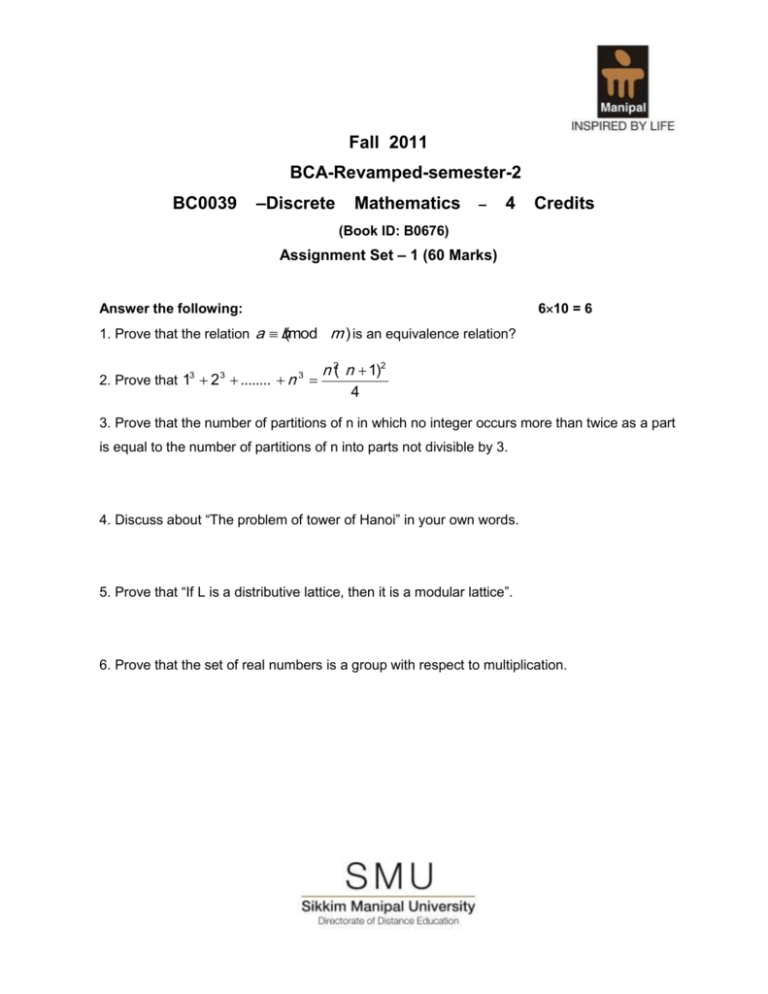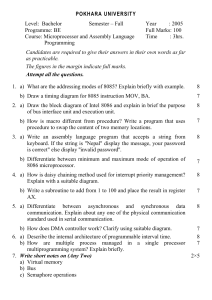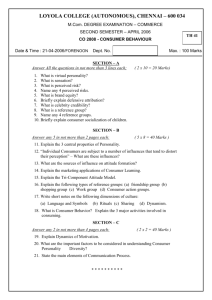Fall 2011 Bachelor of Computer Application (BCA) – Semester 2
advertisement

Fall 2011
BCA-Revamped-semester-2
BC0039
–Discrete
Mathematics
–
4
Credits
(Book ID: B0676)
Assignment Set – 1 (60 Marks)
Answer the following:
610 = 6
1. Prove that the relation a b(mod m ) is an equivalence relation?
3
3
3
2. Prove that 1 2 ........ n
n 2( n 1)2
4
3. Prove that the number of partitions of n in which no integer occurs more than twice as a part
is equal to the number of partitions of n into parts not divisible by 3.
4. Discuss about “The problem of tower of Hanoi” in your own words.
5. Prove that “If L is a distributive lattice, then it is a modular lattice”.
6. Prove that the set of real numbers is a group with respect to multiplication.
Fall 2011
BCA-Revamped-semester-2
BC0039
–Discrete
Mathematics
–
4
Credits
(Book ID: B0676)
Assignment Set – 2 (60 Marks)
Answer the following :
610 = 6
1. Prove that a finite integral domain is a field.
2. Prove that “If S is any subset of a vector space V, then L(S) is a subspace of V”.
3. Show that [p (p q)] ~p is a tautology.
4. Convert the following statements into symbolic language
(i) All beautiful birds are ornately coloured.
(ii) Birds that do not live on honey are dull in colour.
5. If A = {2, 3, 4}, B = {4, 5, 6} and C = {6, 7}, then find the following
(i) (A – B) (B – C)
(ii) (A B) – (B C)
6. Find the domain and range of the function f( x )
1
2 cos 3 x
Fall 2011
Bachelor of Computer Application (BCA) – Semester 2
BC0040 – Computer Organization and Architecture – 4 Credits
(Book ID: B0684)
Assignment Set – 1 (60 Marks)
Answer all questions. Each question carries six marks
10 x 6 = 60
1. Draw the block diagram of von Neumann Architecture and explain about its parts in
brief.
2. What is the function of Program Status Word (PSW)? Explain the function
of each flag that PSW contains.
3. Explain the different types of computer architectures.
4. Draw the block diagram of Intel 8085 CPU organization and explain the different flag
bits supported by the 8085 CPU.
5. What are the different types of Bus used in computer? Explain about its functions.
6. Explain the steps to be followed for the addition of floating point numbers.
7. Explain direct addressing mode and Register addressing Mode with
example.
8. What is memory interleaving? Explain it with necessary figures.
9. Explain the two bus organization and its working principle.
10. Draw the diagram for the control unit organization of computer and
explain how it works.
Fall 2011
Bachelor of Computer Application (BCA) – Semester 2
BC0040 – Computer Organization and Architecture – 4 Credits
(Book ID: B0684)
Assignment Set – 2 (60 Marks)
Answer all questions. Each question carries six marks
10 x 6 = 60
1. Explain the concept of memory interleaving.
2. What are the issues of Vector processing?
3. Write down the characteristics of RISC and CISC.
4. Explain the basic structure of Linear pipeline Processor.
5. Draw the I/O module of computer system and explain its functions.
6. Explain the characteristics of vector processing.
7. What is the significance of stack in computer system? Explain.
8. Explain how pipelining improve the performance of a computer?
9. Draw the flowchart for instruction cycle and explain how it works.
10. Draw the block diagram of DMA controller and explain it briefly.
Fall 2011
Bachelor of Computer Application (BCA) – Semester 3
BC0042 –
Operating Systems
– 4 Credits
(Book ID: B0682)
Assignment Set – 1 (60 Marks)
Answer All Questions (6x10)
1. What are the services provided by Operating Systems? Explain briefly.
2. What is Micro-kernel? What are the benefits of Micro-kernel?
3. Draw the diagram for Unix Kernel components and explain about each components
briefly.
4. Explain seven state process models used for OS with necessary diagram.
5. Define process and threads and differentiate between them.
6. What is a virtual memory? What are its significance in Operating system.?
Fall 2011
Bachelor of Computer Application (BCA) – Semester 3
BC0042 –
Operating Systems
– 4 Credits
(Book ID: B0682)
Assignment Set – 2 (60 Marks)
Answer All Questions (6x10)
1. What are the jobs of CPU scheduler? Explain any two scheduling algorithm.
2. What do you mean by Deadlock? How can deadlock be prevented?
3. Explain the algorithm of peterson’s method for mutual exclusion.
4. Explain how the block size is affected on I/O operation to read the file.
5. Explain programmed I/O and interrupt I/O. How they differ?
6. Explain briefly the architecture of Windows NT operating system.






